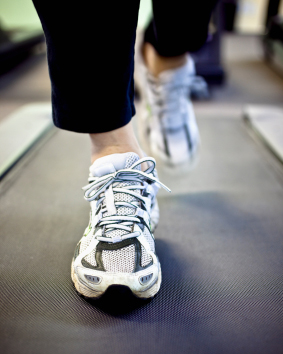Include Aerobic Activities

 Aerobic activity improves your cardiovascular health and helps protect against heart disease. It also improves your physical energy and produces endorphins that improve your mood.
Aerobic activity improves your cardiovascular health and helps protect against heart disease. It also improves your physical energy and produces endorphins that improve your mood.
What you do and how often and hard you exercise are determined by your goals, present fitness level and health, interest, and convenience. It is important to choose an activity you enjoy and that fits your lifestyle and tailor it to your fitness level. This will help you make exercise a habit. It's also a good idea to choose more than one type of exercise to give your body a more complete workout and to avoid boredom.
If you want to increase aerobic benefits, try adding more vigorous activities and increasing the time.
To increase your aerobic effort

Add more vigorous activity
Instead of doing only moderate-level activities, consider replacing some with vigorous aerobic activities that will make your heart beat even faster. Adding vigorous activities provides benefits in less activity time. In general, 15 minutes of vigorous activity provides the same benefits as 30 minutes of moderate activity.
Add more time
Already doing two hours and 30 minutes a week of aerobic physical activity? Good for you! Do you want to gain even more health benefits from physical activity? Slowly add more time to your weekly routine.
Strive to double your weekly activity time. Work to be active five or more hours each week for even more health benefits. A recent study in the Journal of the American Medical Association found that an hour of exercise each day can help adults maintain a healthy weight and avoid long-term weight gain.
You can do all moderate activities, all vigorous activities, or some of each. You should always start with moderate activities and then add vigorous activities little by little.
Helpful tips to get started
One way to set your goals and monitor your level of physical activity is to know your target heart rate. Make your cardiovascular workouts hard enough to break a sweat and get your heart pumping faster. Learn how hard you should work out.
Walking is one excellent cardio-respiratory exercise that almost everyone can do. Walking 10,000 steps a day can improve health and fitness. (It takes a little more than 2,000 steps to walk one mile.) Many people discover when they begin wearing a pedometer that they only average between 900 and 3,000 steps a day. Learn how to start your own walking program.
There are many choices for cardiovascular exercise. Learn some of the pros and cons of each to help you make choices.
How hard should I work out?
You need to raise your heart rate to a certain level called your Target Heart Rate and keep it there for 20 minutes to increase your cardiovascular fitness. Here's how to calculate yours.
How Hard Should I Work Out?
To figure out your Target Heart Rate, use this formula: (220 - your age) x 70%.
For example, if you are 28, it would look like this: 220 - 28 = 192 x 70% = 134 beats/minute.
To check your heart rate during exercise, count your pulse for 10 seconds, then multiply by 6. Compare this to your target rate.
A quick and easy way to assess your level of exertion is to do the "talk test" while exercising. Rate your ability to talk on a scale from 1-10, with 1 being no breathlessness and easy conversation and 10 being extreme breathlessness and inability to talk during exercise.
- If you rate your level of breathlessness between a 1 and 4, you can have a somewhat regular conversation while working out and you are working below 50-60% of your maximum heart rate.
- If you rate your level of breathlessness between 5-10, your sentences are broken, or you are only able to get in a few words and you are working at 70% or above your maximum heart rate.
What activities should I do?
There are lots of options for getting your heart rate up, from biking and running to rowing. But some of them may not be right for you. Check here for the pros and cons of each.
Pros and cons of different activities
Activity |
Pros |
Cons |
|
Walking |
- Excellent beginner activity - Can be done almostanywhere - Minimal stress to joints - Develops and maintains aerobic fitness for most adults |
- For the highly fit, may not be intense enough to reach target heart rate range |
|
Jogging/Running |
- Requires no special equipment except proper shoes - Can be done almost anywhere |
- May stress joints - Safety issues when done on streets and uneven surfaces. |
|
Swimming |
- Excellent overall conditioner - Minimal stress to most joints |
- Need access to a pool |
|
Bicycling/Stationary Cycling |
- Exercises large muscles in legs - Minimal stress to most joints - Can be done indoors |
- Outdoor: safety issues - Indoor: need access to equipment |
|
Aerobic Dance/Step Aerobics |
- Excellent overall conditioner if properly performed - Music and group exercise make it enjoyable |
- May require instruction - High impact can stress joints |
|
Rowing |
- Exercises upper and lower body muscles - Minimal stress on joints if done properly - Effective for aerobic and muscle fitness |
- Need access to equipment |
|
Stair Climber |
- Exercises large muscles in legs - Minimal stress on joints |
- Need access to equipment |
|
Rope Jumping |
- Can be done almost anywhere - Inexpensive |
- Difficult to sustain unless fairly fit - Stresses joints - Skill required for effectiveness |
Lee, I.M., Djoussé, L., Sesso, H.D., Wang, L., Buring, J.E. (2010). Physical activity and weight gain prevention. Journal of the American Medical Association; 303(12):1173-9.
U.S. Department of Health & Human Services 2008 Physical Activity Guidelines: http://www.health.gov/PAGuidelines/guidelines/








